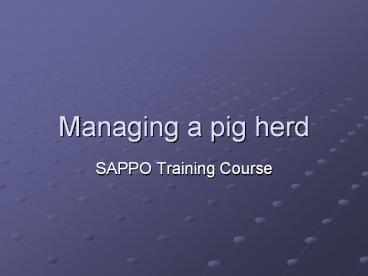Managing a pig herd - PowerPoint PPT Presentation
1 / 24
Title:
Managing a pig herd
Description:
Managing a pig herd SAPPO Training Course Introduction Each age group/development stage has special management requirements to stay healthy and produce well Breeding ... – PowerPoint PPT presentation
Number of Views:92
Avg rating:3.0/5.0
Title: Managing a pig herd
1
Managing a pig herd
- SAPPO Training Course
2
Introduction
- Each age group/development stage has special
management requirements to stay healthy and
produce well - Breeding stock
- Breeding gilts
- Pregnant and lactating sows
- Boars
- Young stock from birth to point of sale
- Piglets before and after weaning
- Weaners and growers
3
Breeding stock
- Their wellbeing and continued high production
depends on - Housing
- Nutrition
- Good breeding management (service, farrowing)
- Health care (vaccination, parasite control)
4
Introducing gilts
- Gilts are usually selected when they are 4-6
months old - At 6-7 months, vaccinate for E. coli and
erysipelas, leptospirosis, parvovirus, with a
booster 4-6 weeks later for both vaccines - Treat for mange and worms
- Feed ad lib until served
- Put them in a pen next to a mature boar to
stimulate them to come on heat - Breed at 7-8 months, modern breeds should weigh
at least 120 kg at service
5
Breeding gilts and sows
- Females come on heat every 3 weeks
- When on heat they will stand firm to hand
pressure on the middle of the back - Females are taken to the boar for service
- Observe mating the boar should remain mounted
and ejaculating for at least 5 minutes - Remove sow after service and repeat 12 and 24
hours later can use a different boar if
available to get larger litters
6
Breeding sows
- Sow on heat stands firm to pressure
- Normal mating
7
Pregnant sows
- Pregnancy lasts about 115 days
- Observe served sows for signs of heat especially
about 3 weeks after first service, and repeat
service if necessary - Vaccinate with E. coli 2-3 weeks before farrowing
date and treat for worms, lice and mange
8
Pregnant sows
- Check for constipation straining, small hard
faeces or none - Feed green feed and wet bran to prevent or
correct constipation
9
Farrowing
- Put sow into farrowing pen about a week before
due date and supply lots of bedding - Stand by during farrowing to help if needed but
do not interfere if process is normal piglets
born 1-2 at a time at about 10-15 minute
intervals - Do not break the umbilical cord
- Can rub and dry piglets and remove membranes from
face - Foster the bigger piglets from large litters with
sows with smaller litters if necessary
10
Farrowing
- Unsupervised farrowing can lead to losses
11
During lactation
- Increase the sows feed to 2-3 times the normal
amount, observe for weight loss and give more if
necessary - Feed at least 3 times a day to prevent excessive
intake at any one time - Ensure that unlimited water is available,
lactating sows can drink at least 30 litres per
day - Wean piglets at 4-6 weeks
- Sow can be served at first heat after weaning if
she is in good condition
12
During lactation
- Sow should not appear thin as piglets grow the
sow in the picture at the bottom is much too thin
13
Managing the boar
- Treat at least 4 times a year for mange, lice and
worms - Breed from about 10 months of age
- Let him serve a quiet sow first if possible
- Do not overwork not more than 3-4 services per
week - Cull when lame, overweight, or not siring good
litters - Avoid boar serving own daughters as it leads to
inbreeding
14
Managing the boar
- A good boar is a valuable asset
15
Care of piglets
- Most piglet deaths occur in the first 3 days of
life - Major causes are cold, starvation, accidents
- Supply a warm creep area
- Make sure that the piglets are suckling well
- Provide a farrowing rail or deep straw to enable
the piglets to get away from the sow so that she
will not accidentally lie on them
16
Creep area
17
Deep bedding
- Deep bedding provides warmth and protection
18
Care of piglets
- Piglets may also die as a result of infectious
diseases or birth defects - Ensure good hygiene in the farrowing pen
- Disinfect the navel and feet with iodine on the
day of birth - Vaccinate and treat the sow for parasites as
described before - Make sure that the piglets suckle as soon as
possible to take in colostrum - Avoid inbreeding
19
Suckling
- Piglets and sow should be calm and happy
- Piglets not suckling and hard red teats mastitis
20
Procedures
- Injection with iron
- Castration
21
Tattooing
- Pigs are tattooed at weaning
22
Care of weaners
- Wean at 4-6 weeks by removing sow and leaving
piglets in farrowing pen for 3-5 days - Feed small amounts of weaner feed from 10 days
before weaning - Restrict feed for 1-2 days after weaning to
prevent over-eating give wet feed - After that feed ad lib, water always available
- Good food, good hygiene, good health management
and timely treatment if necessary are the keys to
success with weaners and growers
23
Mixing litters
- If possible mix piglets of the same size, age,
sex - To prevent excessive fighting
- Provide enough space for them to move apart
- Make sure there is plenty of space at the feeder
- Provide toys pieces of old motor tyres,
sacking, branches to occupy them
24
Any questions?































